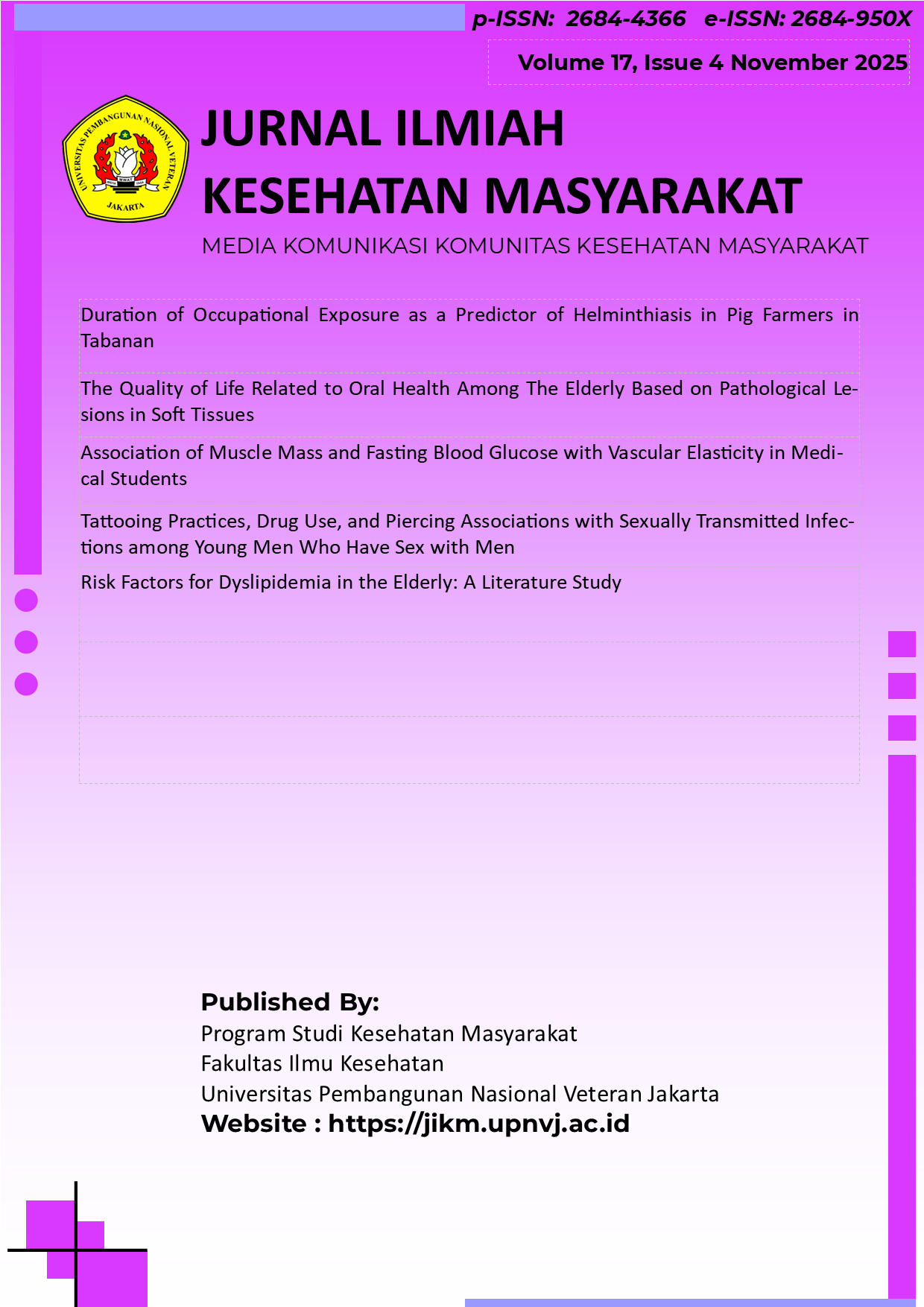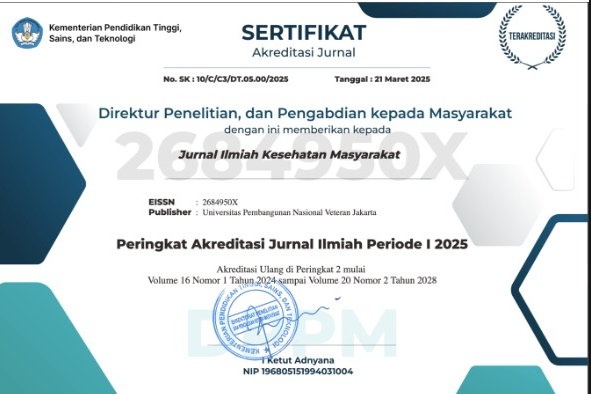Tattooing Practices, Drug Use, and Piercing Associations with Sexually Transmitted Infections among Young Men Who Have Sex with Men
Abstract
Background: Young men who have sex with men in Indonesia face a high vulnerability to sexually transmitted infections. However, evidence on the role of body modification and drug use remains limited. This study examined behavioral correlates of self-reported sexually transmitted infection symptoms.
Methods: Data were obtained from the 2018–2019 Integrated Biological and Behavioral Survey, a cross-sectional respondent-driven sampling study involving 1,988 men aged 18–24 years across multiple Indonesian cities. Weighted logistic regression was used to estimate adjusted odds ratios for sexually transmitted infection symptoms in relation to tattooing, piercing, drug use, condom use, HIV prevention knowledge, and sociodemographic factors.
Results: The prevalence of self-reported sexually transmitted infection symptoms was 22.8%. Tattooing, piercing, and drug use were not independently associated with these symptoms after adjustment. In contrast, low human immunodeficiency viruses (HIV) prevention knowledge (Adjusted OR = 8.53; 95% CI: 2.38–30.4) and inconsistent condom use (never: Adjusted OR = 32.3; 95% CI: 1.34–775.5; occasional: Adjusted OR = 3.57; 95% CI: 1.12–11.4) showed strong associations.
Conclusion: The primary drivers of sexually transmitted infection symptoms among young men who have sex with men were gaps in HIV prevention knowledge and inconsistent condom use, rather than tattooing, piercing, or drug use. Interventions should prioritize sexual health education, condom promotion, and regulatory oversight for body modification practices.
References
Unemo M, Bradshaw CS, Hocking JS, de Vries HJC, Francis SC, Mabey D, et al. Sexually transmitted infections: challenges ahead. The Lancet Infectious Diseases [Internet]. [cited 2025 Sept 2];17(8). Available from: https://www.sciencedirect.com/science/article/pii/S1473309917303109
Sinka K. The global burden of sexually transmitted infections. Clinics in Dermatology [Internet]. 2024 [cited 2025 Sept 42(2). Available from: https://www.sciencedirect.com/science/article/pii/S0738081X23002547
UNAIDS. Fact sheet 2024 - Latest global and regional HIV statistics on the status of the AIDS epidemic. UNAIDS; 2024.
UNAIDS. In Danger: UNAIDs Global AIDs Update 2022. Geneve: unaids; 2022.
Pravitha BP, Prathap P, Asokan N, Sudhiraj TS. The profile of sexually transmitted infections of men who have sex with men: A tertiary care center-based comparative cross-sectional study. Indian Journal of Sexually Transmitted Diseases and AIDS [Internet]. 2023 [cited 2025 Sept 2];44(2). Available from: https://www.ncbi.nlm.nih.gov/pmc/articles/PMC10785116/
Ministry of Health. Executive Report on HIV/AIDS Trends within the PIMS Framework, January–December 2023. Jakarta: Ministry of Health;
Ministry of Health. Executive Report on HIV/AIDS Trends within the PIMS Framework, January–December 2024. Jakarta: Ministry of Health; 2025.
Foerster M, Zins M, Goldberg M, Ribet C, Kab S, Hosseini B, et al. Tattoo practices and risk of hepatitis B and hepatitis C infection in the general population [Internet]. medRxiv; 2024 [cited 2025 Sept 2]. p. 2024.10.25.24316096. Available from: https://www.medrxiv.org/content/10.1101/2024.10.25.24316096v1
Coronado-Muñoz M, García-Cabrera E, Angélica Quintero-Flórez AQF, Román E, Ángel Vilches-Arenas ÁVA. Substance use and sexual risk behaviors among men who have sex with men: A global systematic review - Google Search. Journal of Clinical Medicine [Internet]. [cited 2025 Sept 2];13(6). Available from: https://www.mdpi.com/2077-0383/13/6/1812
Cannovo N, Bianchini E, Gironacci L, Garbati E, Di Prospero F, Cingolani M, et al. Sexually Transmitted Infections in Adolescents and Young Adults: A Cross Section of Public Health. International Journal of Environmental Research and Public Health [Internet]. 2024 [cited 2025 Sept 2];21(4). Available from: https://www.mdpi.com/1660-4601/21/4/501
Bakova D, Yaneva A, Harizanova S, Shopova D, Mihaylova A, Kasnakova P, et al. Monitoring Health Risks Associated with Body Modifications (Tattoos and Permanent Makeup): A Systematic Review. Cosmetics. 2025;12(1).
Tammene A, Yamene B. A Study of Body Modification Artists’ Knowledge, Attitudes, and Practices Toward Infection Control: A Questionnaire-Based Cross-Sectional Study. Risk Management and Healthcare Policy [Internet]. 2022; Available from: https://www.dovepress.com/article/download/74614
Mahmud S, Mohsin M, Muyeed A, Islam MM, Hossain S, Islam A. Prevalence of HIV and syphilis and their co-infection among men having sex with men in Asia: A systematic review and meta-analysis. Heliyon. 2023 Mar 1;9(3):e13947.
Wardani EM, Nugroho RF. Risk Factors for Human Immunodeficiency Virus: Blood Transfusion, Injecting Drug Use, Piercing, and Tatto in Indonesia. South East European Journal of Immunology [Internet]. 2024 [cited 2025 Sept 2];6(1). Available from: https://sciendo.com/article/10.3889/seejim.2023.6034
Nevendorff L, Schroeder SE, Pedrana A, Bourne A, Stoové M. Prevalence of sexualized drug use and risk of HIV among sexually active MSM in East and South Asian countries: systematic review and meta-analysis. J Int AIDS Soc. 2023;26(1).
Fatiah MS, Mollet GCC, Purna R, Bela SRA. The Effect of Being Faithful, Condom Use, no Drug Behavior on the Incidence of Sexually Transmitted Infections (STIs) in Unmarried Men Who Have Sex with Men (MSM) in Indonesia. Unnes Journal of Public Health. 2025;14(1).
Gedele K, Luis H, Wignall FS, Fridayantara WD, Irwanto. A social context perspective to the increasing HIV epidemic in MSM in Indonesia. International Journal of STD & AIDs. 2020;31(13).
Cohen PR. Tattoo-Associated Viral Infections: A Review. Clin Cosmet Investig Dermatol [Internet]. 2021 [cited 2025 Sept 4];14. Available from: https://www.ncbi.nlm.nih.gov/pmc/articles/PMC8549973/
Kondakala S, Yoon S, Daddy-Gaoh S, Foley S, Kweon O, Kim SJ. Microbiology of tattoo-associated infections since 1820. The Lancet Microbe. 2025;6(4).
Peterson CJ, Lee B, Lacy M. Infectious Complications From Body Piercings—A Narrative Review. Infect Dis Clin Pract [Internet]. 2024 [cited 2025 Sept 4];32(3). Available from: https://journals.lww.com/10.1097/IPC.0000000000001366
Yoon S, Kondakala S, Daddy-Gaoh S, Foley S, Kweon O, Kim SJ. Causes, patterns, and epidemiology of tattoo-associated infections since 1820. The Lancet Microbe [Internet]. 2025 [cited 2025 Sept 4];6(4). Available from: https://www.sciencedirect.com/science/article/pii/S266652472400274X
Flores Anato JL, Panagiotoglou D, Greenwald ZR, Blanchette M, Trottier C, Vaziri M, et al. Chemsex and incidence of sexually transmitted infections among Canadian pre-exposure prophylaxis (PrEP) users in the l’Actuel PrEP Cohort (2013–2020). Sexually Transmitted Infections [Internet]. 2022 [cited 2025 Oct 6];98(8). Available from: https://pmc.ncbi.nlm.nih.gov/articles/PMC9685712/
Bolmont M, Tshikung ON, Trellu LT. Chemsex, a Contemporary Challenge for Public Health. The Journal of Sexual Medicine. 2022 Aug 1;19(8):1210–3.
Elin R, Victor W, Yauheni L, Ekström AM, Daniel L. Chemsex and sexual risk behavior among MSM on PrEP in Stockholm, Sweden. Drug Alcohol Depend Rep. 2025;16.
Capodieci S, Zaccarelli M, Stingone C, Giuliani E, Cafaro V, Gianserra L, et al. Chemsex, sexualized drug use and emotional vulnerability among men who have sex with men (MSM): a one-month survey in a STI/HIV center. BMJ Sexually Transmitted Infection. 2024;
Reza MdM, Rana AM, Azim T, Chowdhury EI, Gourab G, Imran MdSA, et al. Changes in condom use among males who have sex with males (MSM): Measuring the effect of HIV prevention programme in Dhaka city. PLoS One [Internet]. 2020 [cited 2025 Sept 4];15(7). Available from: https://www.ncbi.nlm.nih.gov/pmc/articles/PMC7380615/
Abdulai R, Phalane E, Atuahene K, Phaswana-Mafuya RN. Consistent Condom and Lubricant Use and Associated Factors Amongst Men Who Have Sex with Men in Sub-Saharan Africa: A Systematic Review. Sexes. 2024;5(4).
Choi EPH, Wu C, Choi KWY, Chau PH, Wan EYF, Wong WCW, et al. Ehealth interactive intervention in promoting safer sex among men who have sex with men. NPJ Digit Med [Internet]. 2024 [cited 2025 Oct 6];7. Available from: https://pmc.ncbi.nlm.nih.gov/articles/PMC11549451/
Amogne MD, Sanders EJ, Belihu WB, Sundewall J, Agardh A. Condom failure and pre-exposure prophylaxis use experience among female sex workers in Ethiopia: a qualitative study. BMC Public Health [Internet]. 2022 [cited 2025 Oct 6];22. Available from: https://pmc.ncbi.nlm.nih.gov/articles/PMC9158269/
Jain V, Aggarwal S, Nigam K, Kamble B, Kundapur R, Konda D, et al. Risk at the Crossroads: Evaluating the Risk of Sexually Transmitted Infections in High-Risk Groups. Cureus. 17(6):e86459.
Llamosas-Falcón L, Hasan OSM, Shuper PA, Rehm J. A systematic review on the impact of alcohol use on sexually transmitted infections. International journal of alcohol and drug research. 2023;11(1):3–12.
Santos GM, Rowe C, Hern J, Walker JE, Ali A, Ornelaz M, et al. Prevalence and correlates of hazardous alcohol consumption and binge drinking among men who have sex with men (MSM) in San Francisco. PLoS One. 2018;13(8):e0202170.
Goverment of Neval. National HIV Strategic Plan. Ministry of Health and Population Nepal. 2025;
UNAIDS. Status of HIV Programmes in Indonesia | UNAIDS [Internet]. 2025 [cited 2025 Sept 4]. Available from: https://www.unaids.org/en/resources/presscentre/featurestories/2025/february/20250224_indonesia_fs
Widianto S. Indonesia health programmes with USAID on hold, minister says. Reuters [Internet]. 2025 [cited 2025 Sept 4]; Available from: https://www.reuters.com/world/asia-pacific/indonesia-health-programmes-with-usaid-hold-minister-says-2025-02-06/









.jpg)








